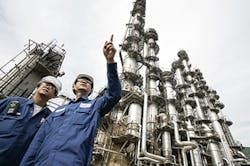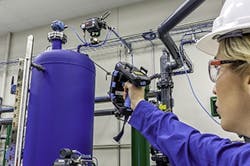Digitization and the adoption of automation technologies based on the Industrial Internet of Things (IIoT) have allowed chemical and petrochemical manufacturers to make strides in improving operational performance that were impossible just five or six years ago. Now, those same developments are starting to change the way processors plan and execute turnarounds, which are the cornerstone of any plant’s maintenance strategy.
Today, many processors are striving to extend the time between turnarounds; such events now usually occur every two to five years. Discrete batch operations typically shut down for 14 to 17 days between batches; turnarounds in continuous process plants can last anywhere from 20 to 40 days.
Turnarounds are costly, risky and complex projects that involve coordinating large amounts of resources in a limited timeframe. They not only are critical for ensuring safety and regulatory compliance but also can have far reaching impact on capital and operating budgets as well as plant performance.
However, as important as they are to profitability, most turnaround projects fail. According to global research consulting firm Independent Project Analysis, Ashburn, Va., 25% of turnarounds run over budget and half don’t finish on schedule. A delay in a post-turnaround startup can easily cause a loss of operating profits that exceeds the cost of the project itself. That’s why removing even an incremental amount of uncertainty from turnarounds can translate into millions of dollars in savings. Digital approaches like predictive analytics, on-site service centers, digital worker tools and location awareness technologies, in concert with expert consulting, can help ensure the right work is done on the right assets at the right time, increasing labor effectiveness and giving companies confidence that turnarounds will be completed safely, on schedule and on budget.
Why Most Turnarounds Fail
One of the main reasons why turnarounds fall short of their budget and schedule goals is scope creep, i.e., when altering the “frozen” scope becomes necessary. This most commonly stems from work that either wasn’t planned at all (discovery) or that changes scope (emergent) during the execution of the turnaround. Discovery work typically accounts for about 11% of the total turnaround work scope and emergent work amounts to about 8%. Both issues wreak havoc with personnel and equipment scheduling when time is at a premium.
Several factors lead to an abundance of scope creep, discovery work and emergent work. We’ll look at the most critical of these in detail, and then discuss how industry leaders are applying digital automation technology and consulting services to address each of these problems to meet safety, schedule and budget key performance indicators.
A resistance to deviate from the status quo — while a psychological hurdle more than anything — probably contributes most to scope uncertainty because it tends to favor repetitive, wasteful, schedule-based maintenance over a more-efficient condition-based approach. Companies often view reverting to the same work scope and scope development practices used during the previous outage as the easiest, most conservative path from a planning perspective. Turnaround planning cycles usually are years long, which means implementing anything new of this size is difficult and takes time. In addition, as processes and the technologies that control them become increasingly complex, some producers fear that disrupting work processes and introducing new technology isn’t worth the risk — at least not yet.
However, that mindset leads to doing maintenance work either according to a pre-determined schedule — regardless of whether it’s needed — or when an incident arises because a problem was missed. This approach reflects a lack of information about the actual health and performance of equipment. Indeed, some assets such as distillation columns, heat exchangers and cooling towers rarely are monitored.
Having an accurate picture of a plant’s asset health and maintenance situation is essential to any successful turnaround, as is ensuring stakeholders always are aligned and in constant communication during every stage of the planning and execution phases of the project. With older facilities, management may not even know exactly what equipment and instrumentation are on site until personnel perform a physical walkdown to log the location and condition of assets as a precursor to the scope development. The shortage of experienced staff is also a common concern.
How well a project’s workforce is trained and whether personnel are armed with the right skills and tools for the job can make or break a turnaround, especially when tight schedules, complex technologies and outside contractors are involved. And, of course, all this directly affects the highest priority — safety. Turnarounds are dangerous events; studies show that about half of all work-related accidents at manufacturing plants occur during planned maintenance outages.
Creating A Roadmap
Thanks to the many advances in digital automation technology, companies now more easily can create scope certainty, gain greater confidence about meeting turnaround schedule and budget goals — and, thus, achieve significant savings. This requires investing in data-driven operations and a digitally empowered workforce to improve planning, alignment, work scope definition and project execution. An increasing number of processors are starting to incorporate more technology into turnaround planning and execution. What many of them need is a clear roadmap to bring all these components together to attain the full potential of digitally transforming their turnaround process.
To realize that potential, a company should follow several best practices:
• Achieve scope assurance with predictive analytics, enabling managers to do the right work on the right assets at the right time.
• Ensure adherence to schedule, labor effectiveness, and safety by leveraging on-site service centers, digital worker tools, and location awareness technology.
• Instill a strategy of early engagement with trusted service partners to increase alignment and effectiveness.
• Perform digital walkdowns with data analytics prior to each turnaround to create an up-to-date electronic record of the installed base to help correctly prioritize work scope.
• Standardize processes and procedures to help streamline work and increase the efficiency of critical workflows.
• Engage experienced and professional service personnel where appropriate.
Improved Scope Definition
Predictive analytics technology has become an extremely powerful tool in helping manufacturers implement more-cost-effective proactive maintenance strategies. Plants first must generate reliable, accurate data to both measure performance and understand asset health. Wireless sensors and intelligent field devices can make installing new measurement points and accessing relevant-time data easier. Once the data are obtained securely, analytics software both on-premise and through cloud-based technology can leverage expertise and human-centered dashboards to generate maintenance recommendations that improve the work scope development during the planning of turnarounds.
Figure 1. Installing basic instrumentation on a distillation column can allow determining the condition of trays.
For example, installing basic flow, temperature and corrosion instrumentation on a trayed distillation column generates data that, when analyzed with machine learning technology, can indicate the precise condition of the trays (Figure 1) — a task that traditionally has required closed-space inspection by personnel. Besides reducing emergent and discovery work once the column is opened, this allows management to order any needed trays in advance, assess whether scaffolding will be necessary, and determine whether to hire outside welding contractors — all of which save time and money.
Data analytics increased scope assurance for a refiner on the U.S. West Coast. The company was able to reduce the number of control valves scheduled for service during a turnaround to 28 from 250 by analyzing trending performance data. By deferring work on a majority of the valves until the following turnaround, it saved $900,000 and hundreds of man-hours. None of the deferred valves experienced any problems between the two turnarounds, which led management to standardize on the use of analytics for work scope development as a best practice for turnarounds across all its sites.
Better Tracking
New automation options and services also are bolstering logistics — fostering schedule assurance, improving safety and enhancing labor effectiveness both leading up to and during turnarounds. Location awareness technology that uses WirelessHART mesh networks to track tags worn by personnel can serve to keep workers out of hazardous work zones or alert to potential accidents by monitoring for abnormal movements such as falls. These systems also allow management to account for personnel at designated muster points during emergencies.
Another important, complex and time-sensitive task is keeping track of all the parts being repaired or replaced. Onsite service centers can help. Emerson, for instance, now offers mobile service centers — complete with equipment, tools, and machinery for calibrating, repairing and testing valves, instrumentation and other parts — that can be transported to the project site. These centers can be customized for the specific equipment planned for attention during the turnaround and expanded if emergent or discovery work is necessary. In many cases, this eliminates the need to order, ship and track parts; or allows plants to order new parts through an onsite procurement desk rather than going through the normal purchase order process, potentially shortening delivery time to days from weeks.
In 2017, a major U.S. refinery was forced to extend its turnaround scope substantially when the number of valves requiring work increased to 120 from 90. By bringing a portable service center to the site, the company was able to finish the project in the original scheduled timeframe.
Time management is as critical as logistics. So, instilling a strategy of early engagement and enabling access to digital capabilities are crucial, not just to increase stakeholder alignment and effectiveness but also to minimize risk and drive project certainty. Planning for turnarounds can start years ahead of time; the greater the extent a processor leverages digital tools and collaborates with automation suppliers, the better all parties can understand the need for the turnaround in terms of meeting both operational and long-term business goals, allowing stakeholders to implement the right mix of digitization tools and applications.
This was the case when a Gulf Coast petrochemical producer hired Emerson to handle instrumentation work during a total site outage in 2017. By engaging 18 months before execution, the company could leverage Emerson’s proven work flow processes along with its own to better allocate resources according to the demand of the project’s schedule. Emerson not only delivered over 15,000 man-hours of incident-free work but also helped the processor come back online early and stay within the project’s instrumentation budget.
Figure 2. Staff can gather data on equipment using RFID tags and mobile software applications.
Streamlined Work Processes
Developing an effective digital transformation strategy for a turnaround requires awareness of the business and operational drivers for the event — as well as a solid understanding of which physical equipment needs servicing. This calls for an installed base record that is reliable, data rich and easy to use. Traditionally, workers performed walkdowns by visually inspecting equipment and process units, and manually noting on worklists items requiring attention during the upcoming turnaround. Today, personnel can create a digital record of a plant’s instrumented installed base using mobile applications (Figure 2). Customized analytics built into the software help management prioritize work scope by examining an asset’s physical condition, age and maintenance record to identify which equipment critically needs refurbishment and which can have work deferred.
Work scope development problems were causing one refiner in the midwestern U.S. to exceed its planned project budgets by as much as 57%. Using digital walkdown, the company saved $485,000 on spare parts and shipping charges, increased worker efficiency by at least 20% during the walkdown phase, and brought the plant within 3% of its planned budget — a major return for a comparatively small investment.
By tapping the knowledge of engineers and automation consultants who understand best practices and know how to standardize turnaround processes and procedures based on years of experience, companies can streamline work and increase the efficiency of critical workflows. In addition, secure cloud-computing technology enables analysis of asset health data generated from the plant floor by off-site experts, who then recommend maintenance actions, allowing the processor to act based on the best possible information available.
A Gulf Coast petrochemical complex clearly benefited from this approach. Managers there embraced predictive maintenance early in the turnaround planning cycle and piloted a condition-monitoring program for critical valves over a 12-month period. Offsite experts analyzed asset performance data over the course of the year, then discussed the results with management and made recommendations about repairs and replacements. The program reduced valve work scope by 30% and allowed the company to defer repair of valves not needing immediate attention to the following turnaround at a savings of almost $500,000.
Another refiner that used valve diagnostics to better understand the health of its control valves decreased turnaround scope by more than 80% and saved over $900,000 on scheduled maintenance activities found unnecessary.
Leveraging expertise and digital tools to determine asset health enabled these processors to evolve from scheduled-based to condition-based maintenance practices, saving hundreds of thousands of dollars and substantially reducing project risk.
Seize The Opportunity
Industrial Info Resources, Sugar Land, Texas, forecasts more than 25,000 turnaround projects will take place in the global manufacturing industries over the next three years. Based on this and internal analyses, Emerson estimates that by improving the accuracy of project scope, eliminating unnecessary work, streamlining turnaround schedules, and boosting labor effectiveness, companies can save as much as 10% on costs and 6% on schedule reductions, which equates to a $76 billion opportunity between now and 2022.
With the right combination of expertise, change management, IIoT-based solutions, and outcome-driven strategies that incorporate carefully chosen business goals, investing in digitally transformed turnarounds today can hugely impact a company’s bottom line for years to come.
JOHN SANDERS is the global director — shutdowns, turnarounds and outages for Emerson Automation Solutions, Bloomington, Minn. Email him at [email protected]




